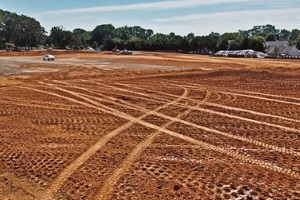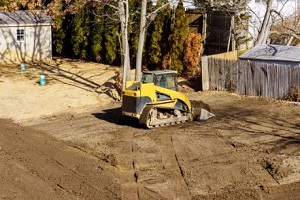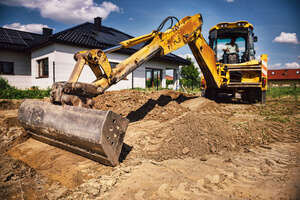 Land grading and land leveling are crucial in land development and construction projects. While these terms are often used interchangeably, they refer to distinct techniques that serve different purposes. Understanding the difference between land grading and land leveling is essential for landowners, developers, and contractors to ensure the successful completion of their projects.
Land grading and land leveling are crucial in land development and construction projects. While these terms are often used interchangeably, they refer to distinct techniques that serve different purposes. Understanding the difference between land grading and land leveling is essential for landowners, developers, and contractors to ensure the successful completion of their projects.
Understanding Land Grading
Land grading is a process that involves reshaping the topography of a piece of land to achieve a desired slope or contour. It is typically performed to improve surface drainage, prevent erosion, create a level surface for construction, or enhance the aesthetics of a landscape.
Land grading techniques employ tools and equipment such as bulldozers, graders, and excavators to move and redistribute soil. The process begins with removing excess soil from high spots and depositing it in low areas to create an even surface. The grading process may also involve adding or removing soil to achieve the desired elevation or slope.
Land grading finds application in various projects, including residential and commercial construction, road and infrastructure development, sports fields, and landscaping. By creating a level surface, land grading facilitates the construction of buildings and structures, ensuring proper stability and functionality. Additionally, it aids in improving water drainage, reducing the risk of flooding and water accumulation.
Proper land grading offers several benefits, such as enhancing the visual appeal of a property, optimizing land use, and minimizing erosion and soil runoff. It also helps promote healthy plant growth by ensuring proper water distribution and eliminating waterlogged areas.
Examining Land Leveling
Land leveling is a distinct process that involves achieving a uniform elevation across a piece of land, eliminating any unevenness or undulations. Unlike land grading, which focuses on reshaping the topography, land leveling aims to create a flat and even surface.
Various techniques and equipment are employed in land leveling, depending on the size and complexity of the project. Graders, scrapers, laser-guided leveling systems, and earthmoving machinery are commonly used to remove high spots and fill low areas, ensuring a consistent elevation. Precise measurements and leveling instruments, such as laser levels, are employed to achieve accuracy in the leveling process.
The applications of land leveling are diverse. It is extensively used in agricultural settings to create a level field for efficient irrigation and crop cultivation. In construction projects, land leveling is crucial for establishing a stable foundation and ensuring proper alignment and elevation of structures. It is also employed in sports field construction, golf course development, and landscaping projects that require a smooth and uniform surface.
Proper land leveling offers several advantages. It promotes efficient water distribution and drainage, minimizing the risk of water stagnation and soil erosion. Additionally, it facilitates ease of access and movement on the land, enhances aesthetics, and allows for optimal land use.
Key Differences Between Land Grading and Land Leveling
 While land grading and land leveling share similarities in their goal of manipulating land topography, key differences between the two processes set them apart.
While land grading and land leveling share similarities in their goal of manipulating land topography, key differences between the two processes set them apart.
Objectives and Outcomes
Land grading primarily focuses on reshaping the topography to address drainage issues, prevent erosion, and create a visually appealing landscape. Its goal is to achieve a desired slope or contour while maintaining the land’s natural features.
On the other hand, land leveling aims to create a flat and even surface with a consistent elevation throughout the area. It prioritizes uniformity and eliminates any unevenness or undulations.
Techniques and Equipment
Land grading involves using equipment such as bulldozers and excavators to redistribute soil and reshape the land. It may require cutting or filling areas to achieve the desired slope. Land leveling, however, often employs specialized leveling equipment, such as graders, scrapers, and laser-guided systems, to remove high spots and fill low areas for a uniformly level surface.
Precision and Accuracy
Land grading allows for a certain degree of natural contouring, accommodating slight variations in the land’s slope. It does not require high precision, as it focuses on achieving a functional and visually pleasing result.
In contrast, land leveling demands higher precision and accuracy to ensure a uniformly flat surface. Laser leveling systems are often used to achieve the desired elevation consistency.
Applications and Scenarios
Land grading finds applications in various projects, including residential and commercial construction, road development, and landscaping. It is suitable when a gentle slope or contour is desired while addressing drainage concerns.
Land leveling is commonly employed in agricultural settings for crop cultivation and construction projects requiring a completely flat surface for foundations or structures.
Factors to Consider When Choosing Between Land Grading and Land Leveling
Several factors must be considered when determining whether to opt for land grading or land leveling for a specific project. These factors influence the choice of technique and ensure the successful implementation of the land development endeavor.
Scope and Purpose of the Project
The land’s intended use and the project’s scope are crucial in selecting the appropriate technique. Land grading is often preferred for projects requiring a gentle slope or contour while addressing drainage concerns. Conversely, land leveling is more suitable if the project requires a completely flat and level surface, such as in agricultural settings or for precise construction needs.
Site Conditions and Topography
The existing topography and conditions of the land are important considerations. Land grading is more flexible in accommodating natural contours and variations, making it suitable for sites with moderate slopes. On the other hand, land leveling is necessary when the land exhibits significant undulations or unevenness that must be rectified.
Budget and Time Constraints
Budgetary limitations and project timelines also impact the choice of technique. Land grading is less costly and time-consuming than land leveling, which may require specialized equipment and precise leveling procedures. Considering the financial and time constraints of the project is crucial in making an informed decision.
Professional Advice and Consultation
 Seeking guidance from professionals, such as land surveyors, engineers, or land development experts, is highly recommended. Their expertise and experience can provide valuable insights into the site’s requirements and help determine the most suitable technique.
Seeking guidance from professionals, such as land surveyors, engineers, or land development experts, is highly recommended. Their expertise and experience can provide valuable insights into the site’s requirements and help determine the most suitable technique.
Consulting with professionals ensures that the chosen technique aligns with the project’s goals and ensures optimal results.
Trust the Land Development Experts
For your land development needs, whether grading, leveling, or other construction projects, consider partnering with Dirt Connections. With our expertise in earthmoving, excavation, and site development, we can assist you in achieving your vision.
To get started, visit our website or contact us today to explore how we can help you with your land development endeavors.
Summary

Dirt Connections was started with one goal in mind: providing quality residential and commercial construction services to clients on time and on budget. Reach out for more information on how we can support your next project.
For your convenience our estimates are free and by appointment. Call 703-940-9949 for a free estimate today!










































